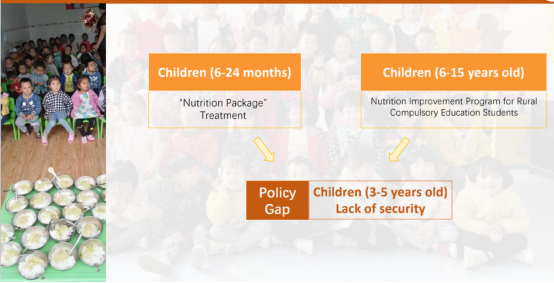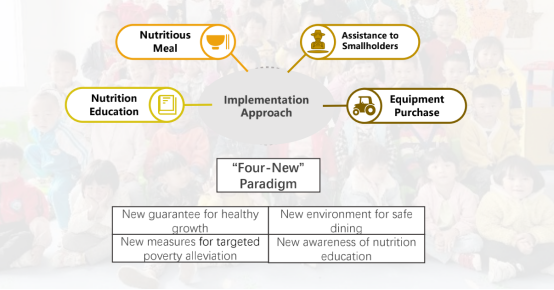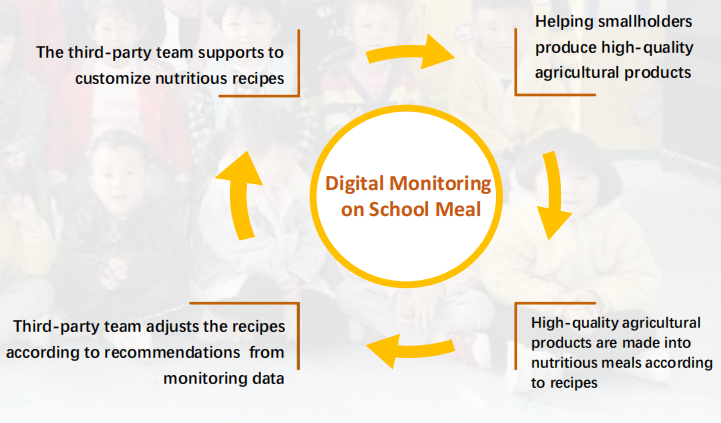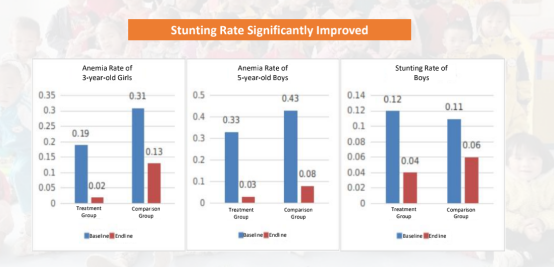● Overview of the project
According to The State of Food Security and Nutrition in the World 2019 - a report released by the UN, although China has made remarkable progress in improving nutrition, there are still more than 6.9 million children age 5 and younger experiencing slowed growth and malnutrition. Most of them live in poverty-stricken areas.
Since 2017, China has carried out a plan to provide micronutrient supplements for infants and children up to 24 months old. Rural students ages 6 to 15 can also enjoy free school meals under the National Student Nutrition Improvement Program.
In 2018, the WFP started its three-year Preschool Nutrition Improvement Pilot Project in two poverty-stricken counties - Yongshun and Longshan - in Xiangxi. The project is aimed at offering healthy, balanced meals for children at 25 local kindergartens and preschools.①
In 2020, 2.16 million yuan ($335,145) was invested in projects in Hunan and Guangxi, benefiting 4,986 children aged 3 to 5 as well as 3,000 to 5,000 impoverished households in rural areas, the WFP said. More than 8,000 preschool children have benefited from the projects.②
The "malnutrition" was the most prominent issue among "left-behind children" in Xiangxi Tujia and Miao Prefecture.
There was a policy children gap among 3-5 years old children (Lack of security).

By improving the dining conditions and nutritious meals for preschool children in township (village) kindergartens, the project aims to improve the nutrition status of children in the pilot project area effectively, reduce the malnutrition rate of children in the project area, and leverage government's inputs to promote policy development and provide an empirical basis for wider replication. At the same time, in alignment with national targeted poverty alleviation program, the project provides precise assistance to poor households in the project area and enhances their ability to participate in the market value chain, so as to effectively increase farmers' income, and consolidate the results of poverty alleviation.
● Approaches and methodology
The project implementation approach mainly includes two parts:nutritious meals and nutrition education.

For nutritious meals,the project sets a model with reference to the current subsidy standard of 4 yuan per student per day for the national nutrition improvement program for rural compulsory education students, and the model of “two meals and a serve of refreshments” and “combination of meat, vegetable and soup” is developed.
Based on the principle of nutritional needs, local seasonal foods are used as the main ingredients to develop mandatory recipes with quantity requirements, providing diverse and seasonal dishes and menus so that kindergarten children can enjoy fresher, more nutritious and diverse meal supplements.
For nutrition education, a local food ecosystem is established to help poor farmers to increase their income and achieve sustainable development of the program. According to the idea of “what young children eat should be what farmers grow”, smallholders are recommended to grow home-grown, nutritious food ingredients, and to adopt traditional organic and pollution free farming methods to produce green and nutritious agricultural products, while kindergartens spend more than 30% of the WFP meal subsidy funds purchasing agricultural products from smallholders in need.
Through the China Development Research Foundation's big data platform, the project's school feeding is monitored dynamically in real time to increase transparency.

● Beneficiary description
Children's nutrition indicators improved significantly.

Diversity of school meal and children's nutrient intake improved significantly.
The project takes local agricultural products as ingredients to establish a local nutrition ecosystem, improve the production capacity of farmers, and increase the income of poor farmers to ensure the sustainable development of the project.
The ability of nutrition, health and food Education in kindergartens improved Significantly.
Multi-party collaboration helps to improve child nutrition. For example, WFP helps leverage the advantageous resources of other enterprises and social organizations, and unites the strengths of all stakeholders in society.
● Reference and recommendation for other countries
After four years of implementation, the Xiangxi project has gained many successful experiences, providing a Xiangxi model for the nutrition improvement of rural preschool children in impoverished mountainous areas, and the project experience has been expanded to WFP's subsequent project areas in Jingxi, Guangxi, Linxia, Gansu and Wangcang, Sichuan. promoting the community to pay attention to the nutrition improvement for preschool children.③
For more information, please contact WFP China COE (wfpcn.coe@wfp.org)

Sources:
① China Daily: UN Agencies Help Nation On Key Fronts
http://www.chinadaily.com.cn/newsrepublic/2019-09/12/content_37509791.htm
② China Daily: Seminar on boosting preschool nutrition held in Beijing
http://global.chinadaily.com.cn/a/202110/13/WS616676b2a310cdd39bc6ea6c.html
③ PPT: Preschool Nutrition Improvement Project In Hunan, China, Presented by Yi Zungang
Related Link:
http://www.wfpchinacoe.net/2023-07/19/content_92955687.shtml
http://www.wfpchinacoe.net/2023-09/06/content_112712106.shtml
Category
WFP Preschool Nutrition Improvement Project In Hunan
Contributor
WFP Preschool Nutrition Improvement Project In Hunan
Country
Case Study

